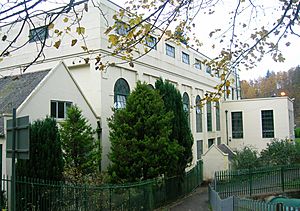Lanark Hydro Electric Scheme facts for kids
Quick facts for kids Lanark Hydro Electric Scheme |
|
|---|---|

Bonnington power station
|
|
| Location | South Lanarkshire, Scotland |
| Coordinates | 55°39′16.85″N 3°46′17.37″W / 55.6546806°N 3.7714917°W |
| Status | Operational |
| Construction began | 1926 |
| Opening date | 1924 |
| Owner(s) | Drax Group |
| Reservoir | |
| Creates | Bonnington Power Station |
| Total capacity | 11 MW |
| Power station | |
| Installed capacity | 17 MW |
The Lanark Hydro Electric Scheme is a cool project in South Lanarkshire, Scotland. It uses the power of water to make electricity! This scheme has two special power plants. They get their water from the amazing Falls of Clyde.
The two power plants are called Bonnington Power Station and Stonebyres Power Station. Bonnington gets water from above Bonnington Linn, near New Lanark. Stonebyres gets water from above Stonebyres Linn, close to Kirkfieldbank. Bonnington is the bigger of the two. Together, they can make 16 megawatts (MW) of power. That's enough to power many homes!
This scheme was the first of its kind in the United Kingdom. It produces clean, renewable energy. It uses water from the waterfalls to power homes. This helped meet the need for electricity after World War I. The Lanark scheme doesn't need big dams to store water. Instead, it uses the natural flow of the waterfalls. Pipes carry the water to the two power stations. They create electricity for over 17,000 homes in the UK. People hope to use this and other natural energy sources to make 40% of the UK's energy by 2020.
The Lanark scheme was a huge technical achievement for Britain. It showed how to use the River Clyde's flow to make power. It's now a great example for sustainable energy around the world.
Contents
History of Lanark Hydro Power
The Lanark Hydro Electric Scheme was the first large-scale hydroelectric plant in the United Kingdom. It was designed by Buchan & Partners. Construction started in 1926 after the Westminster parliament approved the plans in 1924. Bonnington Power Station was finished in 1926. Stonebyres Power Station was completed in 1927.
At first, some people worried about building power stations in such a beautiful area. But Sir Edward MacColl, a chief engineer, had a clever plan. He designed the stations to blend in with the natural landscape. He made sure the beauty of the Clyde Falls was kept safe. The design didn't need a big reservoir. Water still flowed over the falls while also going through special channels to make electricity. This is called a run-of-the-river scheme. It uses the natural flow of the river. Sir Edward's design was so good that it became a model for future hydro schemes.
The Lanark Hydro Electric Scheme was owned by the public for many years. Then, in the 1980s, energy companies became private. Now, the scheme is owned by Drax Group. They bought it from Scottish Power.
How the Power Stations Work
The Lanark scheme has two main buildings: Bonnington and Stonebyres stations. Both buildings look similar. They are single-story buildings made of strong concrete. They have large, rounded windows and smaller rectangular ones. They also have a big, flat roof.
Water is taken from above Bonnington Linn and Corra Linn. This happens using an automatic tilting weir. A weir is like a small dam that controls water flow. This weir helps keep the water level just right. It has three gates that move to control the water. One great thing about being next to the falls is that the stations can run all year. They don't need a reservoir because there's always enough water from the Falls of Clyde. In 1970, both stations started using new types of generators called induction generators.
Protecting Nature at Lanark
Since the hydro stations opened in the 1920s, they have worked hard to produce clean energy. They work with environmental groups like the Scottish Wildlife Trust and the Scottish Environment Protection Agency. They also work with local communities.
In 2005, the Lanark Hydro Electric Scheme started its first plan to protect nature. This plan aimed to protect the animals and plants around the scheme. In 2009, they made a new plan for the next five years. Today, over 1,900 different types of plants and animals live at the Falls of Clyde. Many of these are protected by the UK Biodiversity Action Plan. This includes plants, reptiles, birds, and more. For example, in 1997, they helped protect the peregrine falcon.
The Lanark Hydros get many visitors each year, usually over 60,000 people. The Scottish Wildlife Trust (SWT) offers activities and summer programs. These help teach people about green energy and protecting wildlife. The Lanark Hydro Electric Scheme makes clean energy without putting harmful gases into the air. The facilities also have special systems to catch oil spills. This stops oil from getting into the water and harming nature.
The Future of Lanark Hydro
The Lanark Hydro Electric Scheme has been very successful. Because of this, there are many goals for its future. Scottish Power, one of the companies involved, wants to make the scheme even better. They plan to use other renewable energy sources, like wind power and solar power.
This will help Scotland reach its goal of getting 40% of its energy from renewable sources by 2020. This is a big step in the right direction! Since it was built in 1928, the Lanark scheme has been a great example of how to create renewable energy. It's a fantastic starting point for designing future self-sustaining power generators.

